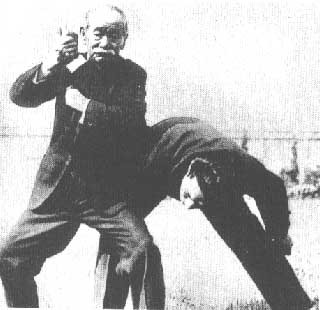WHAT IS JUDO?


Jigoro Kano at demonstration in Vienna

Jigoro Kano throwing Yoshitsugu YAMASHITA with Uki-goshi
JU = GENTLE
DO = WAY
Judo means "GENTLE WAY." GENTLE can also mean softness or flexible as this is important in the principle of Judo by adapting to your opponent's force and indirectly using this force to defeat him or her. For example, instead of being rigid and pushing directly against your opponent, one could step aside allowing your opponent's force and momentum to be thrown forward. "The Way" is a path or philosophy. Jigoro Kano saw this path as a means of improving oneself physically, mentally, and spiritually, so that one can contribute something positive to the world.
Judo is a dynamic sport, martial art, and a means of self-defense that involves techniques that allow you to lift and throw opponents onto their backs and execute ground control to secure pins, choke holds or joint locks until submission. This ability to adapt and manipulate forces of balance, power, and movement in attempt to subdue each other appears simple in theory, but the complexity of the skill to execute these techniques effectively often takes considerable time, effort, and energy.
ORIGINS OF JUDO

Kodokan that was located at Fujimi-cho
The origins of Judo began during feudal Japan of the Samurai era from the twelfth to nineteenth century. The samurai were professional soldiers that not only utilized swords, bows, and arrows, they developed jujutsu to fight enemies at close quarters on the battlefield. As the era of samurai rule came to an end, a young scholar named Jigoro Kano (1860-1938) began studying varying styles of jujutsu in Japan.
Studied Jujutsu Under:
Fukuda, Hachinosuke (1828-1879): Tenjin Shin'yō-ryū.
Grandfather of Keiko Fukuda 9th dan Kodokan and 10th dan USJF/USA Judo (1913-2013)
Masotomo, Isa (1828-1879): Tenjin Shin'yō-ryū.
Tsunetoshi, Likubo (1835-1889): Kitō-ryū
In 1882 Professor Jigoro Kano developed Kodokan (a place to teach the path") Judo school and dojo at Eisho-ji, a Buddhist temple in Kamakura. Kano wanted to integrate and develop techniques based from his studies in jujutsu that focused on "defeating strength through flexibility" into a new principle of "maximum efficient use of physical and mental energy" and "mutual welfare and benefit." Kano embraced these core judo principles upon which the proper goal of judo training would be to the development of improving one-self so that one could be a positive contribution to society.
Studied Jujutsu Under:
Fukuda, Hachinosuke (1828-1879): Tenjin Shin'yō-ryū.
Grandfather of Keiko Fukuda 9th dan Kodokan and 10th dan USJF/USA Judo (1913-2013)
Masotomo, Isa (1828-1879): Tenjin Shin'yō-ryū.
Tsunetoshi, Likubo (1835-1889): Kitō-ryū
In 1882 Professor Jigoro Kano developed Kodokan (a place to teach the path") Judo school and dojo at Eisho-ji, a Buddhist temple in Kamakura. Kano wanted to integrate and develop techniques based from his studies in jujutsu that focused on "defeating strength through flexibility" into a new principle of "maximum efficient use of physical and mental energy" and "mutual welfare and benefit." Kano embraced these core judo principles upon which the proper goal of judo training would be to the development of improving one-self so that one could be a positive contribution to society.

Sensei Keiko Fukuda 10th Dan (1913-2013) and Sensei Mac Takeda 8th Dan
